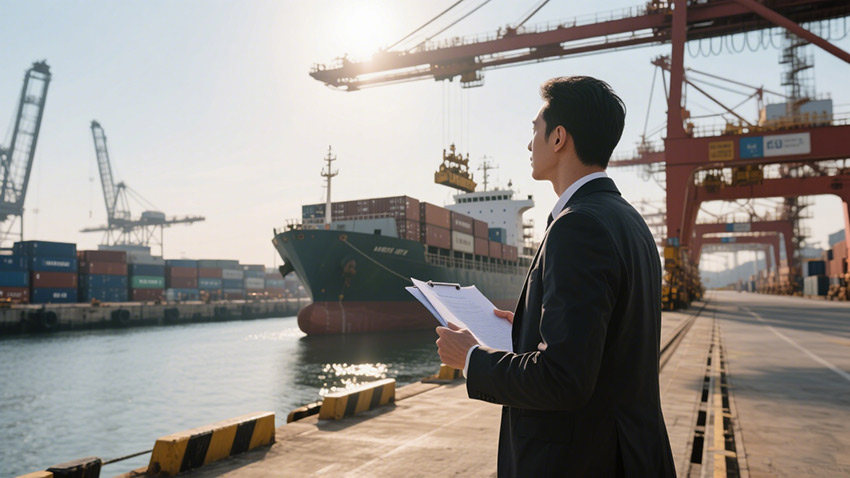In today’s globalized business environment, the B2B market is constantly evolving. For foreign trade sellers, it is crucial to promptly identify market trends and adjust their strategies accordingly. In 2025, the global B2B market is witnessing a series of significant changes that will profoundly impact the business operations of foreign trade sellers. The following are five key changes that foreign trade sellers must be aware of.
1. Intelligent Procurement Transformation Driven by Technology
In 2025, technology has become the core force reshaping B2B procurement services. The deep integration of advanced technologies such as artificial intelligence (AI), big data, and cloud computing is driving the procurement process towards intelligence and automation.
AI algorithms can conduct in-depth analysis of massive amounts of supplier information, product data, and past procurement records. For example, the B2B system of Shushangyun leverages AI to achieve accurate intelligent supplier recommendations based on key factors such as purchasers’ product requirements, price preferences, and delivery time requirements. When a machinery manufacturing enterprise purchases components, the system quickly screens out the most suitable suppliers according to its past procurement habits, product quality standards, and budget constraints, reducing the procurement cycle from several weeks to just a few days and significantly improving procurement efficiency.
Moreover, AI empowers the automation of transaction processes. Take a large chemical enterprise as an example. When it conducts transactions with suppliers through the Shushangyun system, the order processing is fully automated. The system automatically determines the order priority, arranges production and distribution, and completes the signing of electronic contracts and payment according to preset business rules. Human intervention is reduced by 70%, effectively minimizing human errors and enhancing the accuracy and timeliness of transactions. For foreign trade sellers, this means actively embracing intelligent procurement technologies, optimizing the display of their product information to increase exposure in intelligent recommendations, and ensuring smooth integration of transaction processes with intelligent systems to enhance the procurement experience of customers.
According to data from Statista, the global B2B e-commerce market size is expected to exceed $7.9 trillion in 2025, and the efficiency improvement brought about by technological investment is one of the key growth drivers. In the field of intelligent procurement, market research firm Gartner predicts that by the end of 2025, more than 80% of large enterprise procurement departments will adopt AI-assisted decision-making tools, and this trend will gradually penetrate from large enterprises to small and medium-sized enterprises. If foreign trade sellers fail to keep up with this technological transformation wave in a timely manner, they will be at a disadvantage in product promotion and transaction matching, and it will be difficult for them to stand out in the fierce global market competition.
2. In-depth Expansion of Supply Chain Collaboration
With the increasingly fierce market competition and the growing diversification of consumer demands, supply chain collaboration has become a key development direction for B2B e-commerce. B2B e-commerce platforms use digital means to break down information barriers, achieving real-time sharing and transparency of supply chain information. Through intelligent algorithms, platforms can optimize supply chain processes, reduce inventory costs, and improve response speed.
Take an automobile manufacturing enterprise as an example. By closely collaborating with suppliers using the Shushangyun system, suppliers can obtain the enterprise’s production plans and component requirements in real-time, and arrange production and distribution in advance. As a result, the inventory turnover rate has increased by 50%, and the stock-out rate has been reduced to less than 5%, significantly optimizing the entire supply chain ecosystem. For foreign trade sellers, this requires strengthening information communication and cooperation with upstream and downstream partners and establishing in-depth supply chain collaboration relationships. In product supply, it is necessary to ensure the accurate and timely transmission of information, adjust the supply rhythm in line with the purchasers’ production plans, and jointly reduce supply chain costs to enhance overall competitiveness.
In the global supply chain landscape, the Asia-Pacific region leads the growth of the global B2B e-commerce market with a compound annual growth rate of 28%. Many foreign trade sellers in the Asia-Pacific region have actively explored supply chain collaboration. For instance, a Chinese electronics manufacturer collaborated with raw material suppliers in Southeast Asia and logistics partners in Europe and the United States on a B2B e-commerce platform, achieving full-process information sharing from raw material procurement to product delivery to end customers. The manufacturer was able to obtain information on raw material price fluctuations 30 days in advance and adjust the production plan accordingly. The logistics partner optimized the transportation route based on the production progress and customer demands, shortening the product delivery cycle by 20% and greatly enhancing the product’s competitiveness in the international market. For foreign trade sellers, supply chain collaboration is not only a means to improve efficiency but also a key to establishing a differential competitive advantage in the global market. Ignoring supply chain collaboration may lead to problems such as inventory backlogs and delivery delays, which will affect customer satisfaction and long-term cooperative relationships.
3. Precise Push of Personalized Services
With the increasing diversification and personalization of consumer demands, B2B e-commerce platforms in 2025 pay more attention to the precise push of personalized services. By leveraging big data analysis and AI technologies, platforms deeply mine and analyze user behaviors and demands, providing users with personalized product recommendations, pricing strategies, marketing strategies, and other services.
Foreign trade sellers need to make full use of the tools and data provided by the platforms, deeply understand the demand characteristics of purchasers, and accurately position and market their products. For example, for purchasers from different industries and of different sizes, formulate differentiated product packages and pricing plans, and provide customized services to improve purchasers’ satisfaction and loyalty and better grasp market demands and trends.
Research by LinkedIn shows that in B2B marketing, enterprises that adopt personalized content strategies have an average 20% increase in customer engagement and a 15% increase in conversion rates. In an actual business scenario, a foreign trade seller of industrial equipment analyzed data on a B2B platform and found that small manufacturing enterprise purchasers were more concerned about the cost-effectiveness and ease of operation of the equipment, while large enterprise purchasers paid more attention to the stability, intelligent functions, and after-sales service network of the equipment. Based on this, the seller launched basic equipment packages for small enterprises, equipped with easy-to-understand operation manuals and basic after-sales guarantees, with more attractive prices. For large enterprises, it provided high-end customized equipment with functions such as intelligent monitoring and remote operation and maintenance, and established a dedicated after-sales team to provide 24-hour response services. This personalized service strategy increased the seller’s satisfaction among different-sized customer groups by more than 30% and boosted the order volume by 25%. If foreign trade sellers cannot provide personalized services according to the demands of purchasers, their products will be easily homogenized, making it difficult for them to attract and retain customers in the market and causing them to miss business growth opportunities.
4. The Booming Development of Cross-border E-commerce Procurement
In 2025, with the acceleration of globalization and the relaxation of cross-border e-commerce policies, cross-border e-commerce has become an important growth point in the B2B market. B2B e-commerce platforms have established cross-border trade service systems, providing enterprises with one-stop cross-border trade solutions, helping them break through geographical limitations, sell products to the global market, expand business scope, and enhance international competitiveness.
Amazon Business has opened nine overseas sites, including those in the United States, Canada, the United Kingdom, etc., serving many high-quality enterprise buyers in education, healthcare, government, and other sectors. It has a mature and complete service system, offering a large number of business opportunities, such as quantity discounts, online bidding (Spot Buy), online request for quotation (RFQ), and other functions, assisting sellers in obtaining large-volume orders. For foreign trade sellers, this is an excellent opportunity to expand into overseas B2B markets. They should actively join high-quality cross-border B2B platforms, familiarize themselves with platform rules and the demand characteristics of overseas purchasers, optimize products and services, and leverage platform advantages to carry out cross-border business.
China’s cross-border B2B industry has established a mature full-link ecosystem. In 2024, China’s annual export volume reached 25.45 trillion yuan, a year-on-year increase of 7.1%. Emerging markets and countries along the Belt and Road have gradually risen in the status of China’s exports, becoming new growth points. International purchasers prefer suppliers with localization, personalization, and branding capabilities. Against this backdrop, more and more Chinese foreign trade sellers are expanding into overseas markets through cross-border B2B platforms. For example, after a Chinese furniture manufacturer joined a cross-border B2B platform, it adjusted its product design according to the preference of European consumers for environmentally friendly and minimalist furniture and optimized the distribution plan using the platform’s logistics services. As a result, its products successfully entered the markets of many European countries, and the annual sales volume increased fivefold within two years after joining the platform. For foreign trade sellers, the cross-border e-commerce procurement market has huge potential, but it also faces challenges such as differences in policies and regulations, cultural differences, and logistics distribution issues in different countries and regions. Only by fully understanding and adapting to these issues can they succeed in the cross-border B2B market.
5. The Professionalization of Procurement Agency Services
In the field of B2B procurement, the trend of professionalization of procurement agency services has become increasingly evident. Professional procurement agencies, with their professional skills, information resources, and knowledge, provide enterprises with a series of procurement-related services, including joint procurement, procurement outsourcing, procurement consulting, bid document preparation, bidding, inquiry and quotation, contract negotiation, supplier screening and inspection, logistics management, etc.
Take Chinese procurement agencies as an example. As China is the world’s manufacturing hub with a rich variety of products and high cost-effectiveness, it attracts many overseas purchasers. Professional Chinese procurement agencies are familiar with the domestic market situation. They can help overseas purchasers efficiently screen high-quality suppliers, negotiate for reasonable prices, control product quality and delivery times, handle complex logistics and transportation affairs, and reduce procurement costs and risks. Foreign trade sellers should actively establish good cooperative relationships with professional procurement agencies, leverage their channels and resource advantages to expand customer groups and increase product sales volume. At the same time, for sellers with certain strength, they can also consider extending into the procurement agency service field to provide value-added services and enhance market competitiveness.
In June 2025, the Ministry of Finance, the Ministry of Public Security, and the State Administration for Market Regulation jointly launched a special rectification of government procurement to standardize the market order, which also reflects from the side that the procurement agency industry is developing towards greater standardization and professionalization. In actual business, an overseas retailer purchased clothing products through a Chinese procurement agency. Relying on its in-depth understanding of the domestic clothing industrial belt, the procurement agency screened out 20 suppliers that met the quality and price requirements within one month and assisted the overseas retailer in negotiating with the suppliers. Finally, a cooperation was reached, reducing the procurement cost by 15% compared to the original budget. At the same time, the procurement agency followed up the product production and quality inspection throughout the process to ensure on-time delivery, with a product qualification rate of 98%. For foreign trade sellers, cooperating with professional procurement agencies can broaden sales channels and reach more potential customers. Expanding into procurement agency services can open up new profit growth points. However, during the cooperation process, sellers need to pay attention to choosing reputable agencies to ensure their own rights and interests. If they engage in procurement agency services, they need to establish a professional team to improve service quality and reputation.
The changes in the global B2B market in 2025 bring both challenges and numerous opportunities. Foreign trade sellers need to closely monitor market dynamics, actively adapt to these trends, and adjust their business strategies to stand out in the fierce global market competition and achieve sustainable and stable development.










Leave a Reply